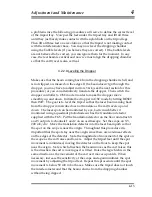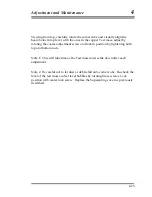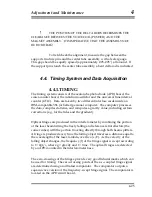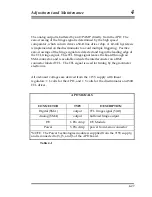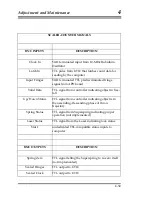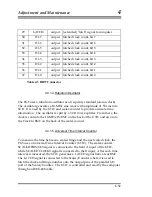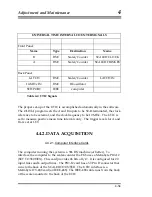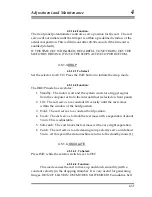
Adjustment and Maintenance
4
lever. Screw on top nut to hold in position then remove the tool. (Set
approximately in center of coarse adjustment screw travel). Rotate test mass
so beam holes in top lever and copper test mass roughly match.
4.3.1.6.Assembling the Superspring
Replace emitter-detector block in the original orientation. The emitter (two
terminal device with red/white wires) should be oriented below lever pivots.
Replace lower triangular spring plate and attach support springs. Slide travel
lock fork assembly onto shaft and re-install the two shoulder screws. Replace
spring assembly into lower plate being careful of voice coil . Note: do this on
a flat surface so the rods seat flush with the bottom of the lower plate , then
tighten barrel clamps. Check movement of center tube by blocking up travel
lock fork assembly (so it doesn’t rub), removing wire tie and foam back, then
gently bouncing center tube and checking to see if it moves freely. NOTE:
Test mass must be centered in cage (hanging plumb), and wires must not
drag. Replace spring assembly into service ring. Insert 6mm screws but don’t
fully tighten. Replace the travel lock assembly. Rotate the main spring
assembly in the service ring so that the travel lock fork has equal clearance
around the two shoulder screws, then tighten 6mm screws.
Install electrical feedthrough. Re-connect all electrical connections. Level the
Superspring by viewing on each side of copper mass and centering in cage
(place entire Superspring on an adjustable table to change where the mass
hangs). Note that the mass should hang down approximately 1.5mm from
the point where it makes contact with the top of the cage assembly as the
system is travel -locked.
4-22
Use the Superspring controller to drive the zero-positioning motor (ZPM)
until the sphere voltage is zero. Measure the gap between the two levers near
the ZPM. Adjust the coarse adjustment screw so that when zeroing the
sphere voltage, the motor will end up in its center of travel position (about
6mm gap between lever arms
±
0.5mm). Note that when you are far off of the
detector the sphere voltage starts at zero and then goes to a maximum and
then over a short range goes through zero (it looks like an S curve). Make
sure sphere detector voltage goes +/- to assure true zero position.
Summary of Contents for FG5
Page 22: ...Design Components and Function 2 Figure 2 10 The Superspring 2 14 ...
Page 31: ...Design Components and Function 2 Figure 2 13 Rotation Monitor 2 23 ...
Page 32: ......
Page 42: ...How to Set Up and Run the FG5 3 3 10 ...
Page 44: ...How to Set Up and Run the FG5 3 Figure 3 2 V Post 3 12 ...
Page 53: ...How to Set Up and Run the FG5 3 1 Backup the data 2 Shut off computer power 3 21 ...
Page 87: ...Adjustment and Maintenance 4 4 29 ...
Page 91: ...Adjustment and Maintenance 4 4 33 ...
Page 104: ...Troubleshooting 5 5 2 ...
Page 117: ...Troubleshooting 5 5 15 ...
Page 131: ...Checklists and Logs Appendix D 9 3 ...
Page 140: ...Checklists and Logs Appendix D Table 9 6 Replacing Drive Belt 9 12 ...
Page 145: ...Checklists and Logs Appendix D Table 9 10 Replace Linear Bearings 9 17 ...
Page 149: ...Checklists and Logs Appendix D Table 9 13 Replace Shaft Encoder 9 21 ...






